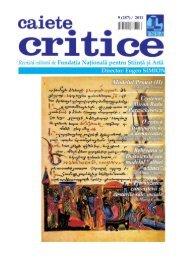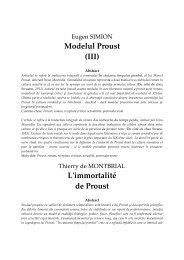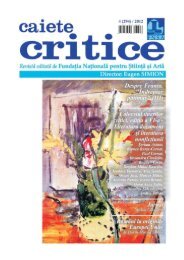Tot despre modelul grec în cultura română: parabole ... - Caiete Critice
Tot despre modelul grec în cultura română: parabole ... - Caiete Critice
Tot despre modelul grec în cultura română: parabole ... - Caiete Critice
You also want an ePaper? Increase the reach of your titles
YUMPU automatically turns print PDFs into web optimized ePapers that Google loves.
man. Thus, there is in man a hierarchy in the<br />
modes in which the world is perceived,<br />
which evolves through an ascensive movement,<br />
by means of which reason leads<br />
towards the Absolute: from sensory knowledge<br />
to rational knowledge, Santayana<br />
shows, man’s spirit ascends successive levels<br />
which each time introduce new intellectual<br />
necessities, that are ever more elaborate,<br />
the last level possible being spiritual<br />
knowledge, which implies the process of<br />
transcending by aesthetic and mystical contemplation<br />
3 .<br />
It is not by accident that we here compare<br />
a man of science (Prigogine) with a<br />
man of letters (Santayana): the boundary<br />
between literature/art/the humanities and<br />
science is largely artificial, the two vast<br />
fields being closely connected in that scientific<br />
discoveries often take place through<br />
artistic/creative imagination, while artistic<br />
52<br />
Mihai A. Stroe<br />
creativity often is the result of profound<br />
knowledge of physical phenomena or<br />
“facts”. The two are aspects of spirit, forming<br />
a unifying dialectics, which justifies the<br />
thesis that the role of literature and art in<br />
general must be reconsidered in modern<br />
science, just as the role of science in general<br />
must be reevaluated in modern literary<br />
studies – something that is already happening,<br />
as can bee seen in recent works (which<br />
seem to be increasingly more numerous<br />
every year) such as Pamela Gossin’s<br />
Encyclopedia of Literature and Science (2002).<br />
In the system of one of the most famous<br />
of the romantic poets, William Blake, mystical<br />
contemplation was precisely a defining<br />
capacity of the true spiritual man, as is suggested<br />
by Santayana. In other words, man’s<br />
cognitive “ascent” implies an increase of the<br />
global structural complexity of the human<br />
being (i.e. a spiritual evolution), and,<br />
through it, implicitly of integral reality (see<br />
for instance Teilhard de Chardin: the law of<br />
complexity and of conscience: “the more<br />
complexity, the more conscience” 4 ).<br />
With this work, Santayana seems to have<br />
anticipated also Ken Wilber’s idea regarding<br />
integral semiotics: Wilber shows that in<br />
“integral reality” there are more hierarchic<br />
cognitive spaces, the emotional, magic,<br />
mythical, rational, existential, psychic, subtle,<br />
causal, nondual. Wilber’s emotional,<br />
rational and nondual spaces approximately<br />
correspond to Santayana’s three types of<br />
knowledge. The consequence implied by<br />
this idea is that in essence reality is psychiccognitive<br />
in nature (something that C. G.<br />
Jung demonstrated empirically) and hierarchically<br />
ordered in accordance with laws of<br />
increasing structural complexity, a phenomenon<br />
forming the basis of Arthur Koestler’s<br />
and Ken Wilber’s holonic-holarchic theory<br />
(in this theory, holons are entities that are<br />
simultaneously parts and wholes).<br />
Similar to Prigogine’s theory, chaos theory<br />
studies the behaviour of dynamic lifeless<br />
systems (for instance, air and water cur-<br />
3 Cf. George Santayana, The Life of Reason or the Phases of Human Progress, 5 vol., 1952-1953, apud Denis<br />
Huisman, Dicþionar de opere majore ale filosofiei, 2001, p. 471.<br />
4 Ken Wilber, Sex, Ecology, Spirituality – The Spirit of Evolution, 1995, p. 113.







